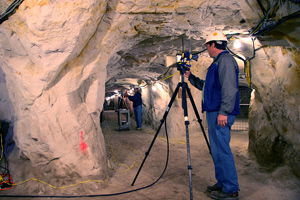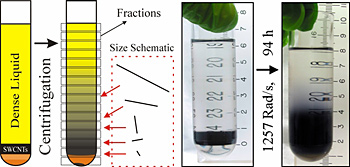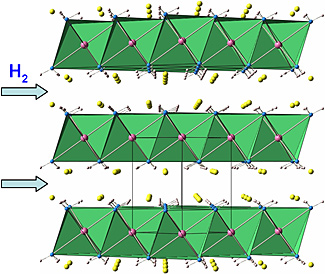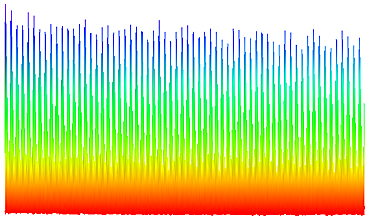| May 13, 2008

[NIST Tech Beat Search] [Credits] [NIST Tech Beat Archives] [Media Contacts] [Subscription Information]

Emergency Links: NIST Identifies ‘Sweet Spot’ for Radios in Tunnels
 |
Electronics engineer Dennis Camell (foreground) aligns antennas in an old California silica mine for a NIST study identifying optimal frequencies for radio signal transmissions in tunnels.
Credit: G. Koepke/NIST
View hi-resolution image |
As part of a project to improve wireless communications for emergency responders, researchers at the National Institute of Standards and Technology (NIST) have confirmed that underground tunnels—generally a difficult setting for radios—can have a frequency “sweet spot” at which signals may travel several times farther than at other frequencies. The finding, which uses extensive new data to confirm models developed in the 1970s, may point to strategies for enhancing rescue communications in subways and mines.
The optimal frequency depends on the dimensions of the tunnel. For a typical subway-sized tunnel, the sweet spot is found in the frequency range 400 megahertz (MHz) to 1 gigahertz (GHz). This effect is described in one of two new NIST publications.* The reports are part of a NIST series contributing to the first comprehensive public data collection on radio transmissions in large buildings and structures. Historically, companies have designed radios based on proprietary tests. The NIST data will support the development of open standards for design of optimal systems, especially for emergency responders.
NIST researchers were surprised by how much farther signals at the optimal frequency traveled in above-ground building corridors, as well as underground. Tunnels can channel radio signals in the right frequency range because they act like giant waveguides, the pipelike channels that confine and direct microwaves on integrated circuit wafers, and in antenna feed systems and optical fibers. The channel shape reduces the losses caused when signals are absorbed or scattered by structural features. The waveguide effect depends on a tunnel’s width, height, surface material and roughness, and the flatness of the floor as well as the signal frequency. NIST authors found good agreement between their measured data and theoretical models, leading to the conclusion that the waveguide effect plays a significant role in radio transmissions in tunnels.
Lead author Kate Remley notes that the results may help design wireless systems that improve control of, for example, search and rescue robots in subways. Some handheld radios used by emergency responders for voice communications already operate within the optimal range for a typical subway, between around 400 MHz and 800 MHz. To provide the broadband data transfer capability desired for search and rescue with video (a bandwidth of at least 1 MHz), a regulatory change would be needed, Remley says.
The tunnel studies were performed in 2007 at Black Diamond Mines Regional Park near Antioch, Calif., an old complex used in the early 1900s to extract pure sand for glass production.
The second new NIST report** describes mapping of radio signals in 12 large building structures including an apartment complex, a hotel, office buildings, a sports stadium and a shopping mall.
The research is supported in part by the U.S. Department of Justice and the Department of Homeland Security. Both reports will be available on NIST’s Metrology for Wireless Systems Web page.
* K. A. Remley, G. Koepke, C. L. Holloway, C. Grosvenor, D.G. Camell, J. Ladbury, R.T. Johnk, D. Novotny, W.F. Young, G. Hough, M.D. McKinley, Y. Becquet and J. Korsnes. “Measurements to Support Modulated-Signal Radio Transmissions for the Public-Safety Sector”. NIST Technical Note 1546, April, 2008.
** C. L. Holloway, W.F. Young, G. H. Koepke, K. A. Remley, D. G. Camell and Y. Becquet. “Attenuation of Radio Wave Signals Into Twelve Large Building Structures”. NIST Technical Note 1545.
Edited May 16, 2008 to add link for TN 1545.
Media Contact: Laura Ost, laura.ost@nist.gov, (303) 497-4880 

Spin Control: New Technique Sorts Nanotubes by Length
 |
In a schematic of NIST's length separation technique for carbon nanotubes (l.), the nanotubes start at the bottom of a dense fluid. When spun in a centrifuge, the nanotubes begin to migrate through the fluid driven by their buoyancy, but the longer ones move faster, spreading them out by length. Photos (r.) shows a typical sample at the start and after 94 hours of spinning at 1257 radians per second (roughly 12,000 RPM).
Credit: NIST
View hi-resolution image |
Researchers at the National Institute of Standards and Technology (NIST) have reported* a new technique to sort batches of carbon nanotubes by length using high-speed centrifuges. Many potential applications for carbon nanotubes depend on the lengths of these microscopic cylinders, and one of the most important features of the new technique, say the scientists, is that it should be easily scalable to produce industrial quantities of high-quality nanotubes.
So-called single wall carbon nanotubes (SWCNTs) are essentially sheets of carbon atoms only one atom thick that have rolled themselves into tubes with a diameter of approximately one nanometer. They have unique combinations of thermal, mechanical, optical and electronic properties that suggest a wide variety of uses, including circuit elements in molecular electronics, fluorescent tags for diagnostic and therapeutic applications in medicine and light sources for compact, efficient flat-panel displays, among many others.
Unfortunately, the methods for manufacturing carbon nanotubes always create a large percentage of nanojunk in the mix—clumps of carbon, ordinary soot, particles of metal used as a catalyst—and nanotubes come in an enormous range of lengths, from a few tens or hundreds, up to thousands of nanometers. Refining the lot is essential for most uses. For many potential applications, nanotubes need to be separated by length. In biomedical applications, for example, it has been shown that whether or not nanotubes are taken up in cells depends critically on length (see “Study: Cells Selectively Absorb Short Nanotubes.”) Nanotubes used as components in future microcircuits obviously need to fit in place, and in optical applications, a nanotube’s length determines how strongly it will absorb or emit light (see “Longer is Better for Nanotube Optical Properties.”)
In 2006, researchers found that you could separate nanotubes by “chirality” (a measure of the twist in the carbon atom sheet) by spinning them in a dense fluid in an ultracentrifuge tube because of a relationship between chirality and buoyancy. In this new work, a team of NIST researchers demonstrated that a variation of the same technique can separate nanotubes by length. They showed that while the nanotubes ultimately will move to a point of equilibrium in the centrifuge tube dictated by their buoyancy, due to friction they will move at different rates depending on their lengths.
“When we spin the centrifuge, it turns out that the longer ones move faster. We basically just run a race and the longer ones move farther in the same amount of time,” says researcher Jeffrey Fagan, “Eventually they get separated enough in position that we can just pull off layers and get different lengths.”
What’s particularly exciting, they say, is that while other techniques have been shown to sort nanotubes by length, this is the first approach that could be scaled up to produce commercially important quantities of nanotubes in a given length range. The process also removes much of unwanted junk—particularly metal particles—from the batch. NIST has applied for a patent on the process.
* J.A. Fagan, M.L. Becker, J. Chun and E.K. Hobbie. Length fractionation of carbon nanotubes using centrifugation. Advanced Materials. 2008. 20. 1609–1613.
Media Contact: Michael Baum, michael.baum@nist.gov, (301) 975-2763 

Improved Ion Mobility Is Key to New Hydrogen Storage Compound
 |
The atomic structure of the mix of lithium amide with lightweight metal hydrides shows layers of calcium that the lithium ions can sprint through. This facilitates hydrogen storage and release.
Credit: NIST
View hi-resolution image |
A materials scientist at the National Institute of Standards and Technology (NIST) has deciphered the structure of a new class of materials that can store relatively large quantities of hydrogen within its crystal structure for later release. The new analysis* may point to a practical hydrogen storage material for automobile fuel cells and similar applications.
The abundant element hydrogen could play a role in replacing carbon-based fuels for transportation in the future, but researchers first must develop a method to store and release large amounts of the highly flammable, odorless invisible gas economically and safely. There are materials that are known to trap relatively large quantities of hydrogen, at normal pressures, but to date they all require heating to fairly high temperatures to release the hydrogen.
Hui Wu, a research associate from the University of Maryland working in a cooperative research program at the NIST Center for Neutron Research, has been investigating a new hydrogen storage compound that mixes lithium amide with lightweight metal hydrides. Lithium amide can hold more than 10 percent of hydrogen by weight, well above the 6 percent target set by the U.S. Department of Energy as a 2010 goal for a hydrogen storage material for transportation. The material absorbs and releases hydrogen reversibly, but both absorbing and releasing the hydrogen requires high temperatures and also produces a toxic byproduct, ammonia.
Metal hydrides also store hydrogen, though not as well, but recently it’s been shown that a combination of the two not only can store significant quantifies of hydrogen but also can release it at lower temperatures than the lithium amide alone (about 100 degrees Celsius) while generating much less ammonia.
To understand how the compound achieves this, Wu used neutron analysis to work out the atomic structure of the material, which she found consists of layers of calcium between which lithium ions travel rapidly. The easy travel allows the material to transfer the hydrogen at lower temperatures. Also the hydrogen ions in the amide and hydride mixture combine easily and release hydrogen at lower temperature without creating much ammonia.
“I found that the mobility of small ions in the mixed amide-hydride system greatly improves hydrogen storage properties,” Wu explains. “This finding helps us understand how hydrogen travels in and out of these systems and that may lead to a rational development of better materials for hydrogen storage.”
* H. Wu. Structure of ternary imide Li2Ca(NH)2 and hydrogen storage mechanisms in amide-hydride system. Journal of the American Chemical Society ASAP Article, Web release date: April 30, 2008
Media Contact: Evelyn Brown, evelyn.brown@nist.gov, (301) 975-5661 

Record-setting Laser May Aid Searches for Earthlike Planets
 |
Experimental data from a NIST “gap-toothed” frequency comb that is false colored to indicate the range from low power (red) to high power (blue). The comb is specially designed for astronomy. Each “tooth” is a precisely known frequency, and the teeth are widely separated (by 20 gigahertz) in comparison to a standard comb.
Credit: M. Kirchner & S. Diddams/NIST
View hi-resolution image |
Scientists at the University of Konstanz (Germany) and the National Institute of Standards and Technology (NIST) have demonstrated an ultrafast laser that offers a record combination of high speed, short pulses and high average power. The new laser is expected to have a range of applications from gas sensors to communications, but in particular, say researchers, it could boost the sensitivity of astronomical tools searching for other Earthlike planets as much as 100 fold.
The dime-sized laser, described last week at the Conference on Lasers and Electro-Optics,* emits 10 billion pulses per second, each lasting about 40 femtoseconds (quadrillionths of a second). The short, fast pulses make it ideal for use as a “frequency comb”—an ultraprecise technique for measuring frequencies of light. It is 10 times faster than a standard NIST frequency comb, produces much shorter pulses than comparable lasers, and is 100 to 1000 times more powerful than typical high-speed lasers, producing clearer signals in experiments. It was built by Albrecht Bartels at the Center for Applied Photonics of the University of Konstanz in Germany.
As a frequency comb the laser could sharpen the search for planets orbiting distant stars. Astronomers look for slight variations in the apparent colors of starlight over time that are caused by the star wobbling from the gravitational pull of an orbiting planet. The effect is very subtle, and astronomers are limited by the frequency standards they use to calibrate their instruments. Frequency combs could be such superior calibration tools that they would make it possible to detect even tiny Earthlike planets that cause color shifts equivalent to a star wobble of just a few centimeters per second. Current instruments can detect—at best—a wobble of about 1 meter per second.
Frequency combs normally have “teeth”—calibration points—too finely spaced for astronomical instruments to read. The faster laser is one approach to solving this problem. In a related paper,** the NIST group and astronomer Steve Osterman at the University of Colorado at Boulder describe how they can filter out periodic blocks of teeth to create a gap-toothed comb. Bouncing the light between carefully positioned mirrors leaves only every 10th or 20th tooth, which is just right for astronomy.
The dime-sized laser is very simple in construction and produces powerful and extremely well-defined comb teeth, and the filtering technique can cover a broader range of wavelengths. Four or five filtering cavities in parallel would provide a high-precision comb of about 25,000 evenly spaced teeth that spans the visible to near-infrared wavelengths (400 to 1100 nanometers), NIST physicist Scott Diddams says.
A number of major institutions, including the Max-Planck Institute for Quantum Optics and the Harvard Smithsonian Center for Astrophysics are interested in the use of frequency combs for planet discovery. Other potential applications of the new laser include direct measurements of the expansion of the universe, remote sensing of gases for medical or atmospheric studies, and on-the-fly precision control of high-speed optical communications to provide greater versatility in data and time transmissions.
Background on frequency combs and NIST’s role in their development can be found at Optical Frequency Combs.
* A. Bartels, D. Heinecke and S.A. Diddams. Passively mode-locked 10 GHz femtosecond Ti:sapphire laser with >1 mW of power per frequency comb mode. Post-deadline paper presented at Conference on Lasers and Electro-Optics (CLEO), San Jose, Calif., May 4-9, 2008.
** D.A. Braje, M. S. Kirchner, S. Osterman, T. Fortier and S. A. Diddams. Astronomical spectrograph calibration with broad-spectrum frequency combs. To appear in European Physics Journal D.
Media Contact: Laura Ost, laura.ost@nist.gov, (303) 497-4880 

Disorder Enables Extreme Sensitivity in Piezoelectric Materials
A research team working at the National Institute of Standards and Technology (NIST) has found an explanation for the extreme sensitivity to mechanical pressure or voltage of a special class of solid materials called relaxors.* The ability to control and tailor this sensitivity would allow industry to enhance a range of devices used in medical ultrasound imaging, loudspeakers, sonar and computer hard drives.
Relaxors are piezoelectrics—they change shape when a battery is connected across opposite ends of the material, or they produce a voltage when squeezed. “Relaxors are roughly 10 times more sensitive than any other known piezoelectric,” explains NIST researcher Peter Gehring. They are extremely useful for device applications because they can convert between electrical and mechanical forms of energy with little energy loss.
A team of scientists from Brookhaven National Laboratory, Stony Brook University, Johns Hopkins University and NIST used the neutron scattering facilities at the NIST Center for Neutron Research (NCNR) to study how the atomic “acoustic vibrations,” which are essentially sound waves, inside relaxors respond to an applied voltage. They found that an intrinsic disorder in the chemical structure of the relaxor crystal apparently is responsible for its special properties.
Atoms in solids are usually arranged in a perfect crystal lattice, and they vibrate about these positions and propagate energy in the form of sound waves. In typical piezoelectric materials, these acoustic vibrations persist for a long time much like the ripples in a pond of water long after a pebble has been thrown in.
Not so with relaxors: these vibrations quickly die out. The research team led by Brookhaven’s Guangyong Xu, compared how the sound waves propagated in different directions, and observed a large asymmetry in the response of the relaxor lattice when subjected to an applied voltage.
“We learned that the lattice’s intrinsic chemical disorder affects the basic behavior and organization of the materials,” says Gehring. The disorder that breaks up the acoustic vibrations makes the material structurally unstable and very sensitive to applied pressure or an applied voltage.
That disorder occurs because the well-defined lattice of atoms alternates randomly between one of three of its elements—zinc, niobium and titanium—each of which carries a different electrical charge.
The research was funded by the Office of Basic Energy Sciences within the U.S. Department of Energy’s Office of Science and the Natural Science and Research Council of Canada.
* G. Xu, J. Wen, C. Stock and P.M. Gehring. Phase instability induced by polar nanoregions in a relaxor ferroelectric system. Nature Materials. Published online May 11, 2008.
Media Contact: Evelyn Brown, evelyn.brown@nist.gov, (301) 975-5661 

Public Invited to See Nanosoccer Robots in Action in Pittsburgh
 |
A photograph of a typical nanosoccer robot compared in size to red blood cells. About 200 of these robots could stretch in a line across the top of a plain M&M candy.
Credit: Craig McGray
View hi-resolution image |
Nanosoccer returns to the field later this month, when the National Institute of Standards and Technology (NIST) hosts for the second time the world’s most Lilliputian sport. Three student teams will participate in a public exhibition at the 2008 U.S. “RoboCup Open” in Pittsburgh, Pa., May 25 to 27, where miniature “soccer players”—computer-driven robots six times smaller than an amoeba operating on a field the size of a grain of rice—will show off their skills.
The teams from Carnegie-Mellon University (Pittsburgh, Pa.), the U.S. Naval Academy (Annapolis, Md.) and the University of Waterloo (Waterloo, Ontario, Canada) will meet at the Carnegie Science Center in Pittsburgh, Pa., to put their nanobots (nanoscale robots) through their paces. The nanobots will be demonstrating agility, maneuverability, response to computer control and ability to move objects—all tools that future miniaturized mechanized workers will need for tasks such as microsurgery within the human body or the manufacturing of atom-sized components for microscopic electronic devices.
RoboCup is an annual international competition designed to foster innovations and advances in artificial intelligence and intelligent robotics by using the game of soccer as a testing ground. NIST’s goal in coordinating competitions between the world’s smallest robots is to show the feasibility and accessibility of technologies for fabricating MicroElectroMechanical Systems (MEMS), tiny mechanical devices built onto semiconductor chips and measured in micrometers (millionth of a meter).
The soccer nanobots are operated by remote control under an optical microscope. They move in response to changing magnetic fields or electrical signals transmitted across the microchip arena. Although the bots are a few tens of micrometers to a few hundred micrometers long, they are considered “nanoscale” because their masses range from a few nanograms to a few hundred nanograms. They are manufactured from materials such as aluminum, nickel, gold, silicon and chromium.
Among the nanosoccer drills that will be demonstrated in Pittsburgh are the two-millimeter dash in which nanobots seek fast times for a goal-to-goal sprint across the playing field; a slalom course where the path between goals is blocked by “defenders” (polymer posts); and a ball handling exercise that requires robots to move “nanoballs” (spheres with the diameter of a human hair) into the goal. One team even plans to conduct its runs underwater to lessen friction.
RoboCup and NIST are jointly organizing the upcoming U.S. Open nanosoccer demonstration as the final step toward the first official Nanogram League competition for soccer nanobots at the 2009 international RoboCup event in Austria.
For more information about NIST and nanosoccer, see “2007 RoboCup Nanogram Demonstration Competition”.
Media Contact: Michael E. Newman, michael.newman@nist.gov, (301) 975-3025 

Bitter Orange SRMs: Tools for Product Analysis/Quality
The National Institute of Standards and Technology (NIST) has developed Standard Reference Materials (SRMs) for bitter orange, long used in folk medicine and now increasingly used in herbal weight-loss products. Researchers can use the new materials to develop and test analytical methods for compounds in bitter orange, or as control materials for quality assurance of their measurements. The NIST samples do not offer scientific evidence to address the use of bitter orange for health purposes.
Also known as Seville orange, sour orange, and Zhi shi, bitter orange has been used in traditional Chinese medicine and by indigenous people of the Amazon rain forest for nausea, indigestion and constipation. Current uses of bitter orange are for heartburn, loss of appetite, nasal congestion and weight loss. Users also apply it to skin for fungal infections such as ringworm and athlete’s foot.
Bitter orange has been used as a substitute for ephedra, a dietary supplement for weight loss now banned by the U.S. Food and Drug Administration (FDA). The dried fruit and peel of bitter orange (and sometimes the flowers and leaves) are taken by mouth in extracts, tablets and capsules. Bitter orange oil also can be applied to the skin. NIST supplies standardized samples of bitter orange in three forms that represent different analytical measurement challenges: ground fruit, extract and solid oral dosage form (tablets).
The National Institute of Health’s (NIH) National Center for Complementary and Alternative Medicine (NCCAM) affirms that “there is not enough scientific evidence to support the use of bitter orange for health purposes.” It notes “many herbal weight-loss products now use bitter orange peel in place of ephedra. However, bitter orange contains the chemical synephrine, which is similar to the main chemical in ephedra. The U.S. FDA banned ephedra because it raises blood pressure and is linked to heart attacks and strokes: it is unclear whether bitter orange has similar effects. There is currently little evidence that bitter orange is safer to use than ephedra.”
The new bitter orange reference materials include SRM 3258 (ground fruit), SRM 3259 (extract) and SRM 3260 (solid oral dosage form). In addition the three SRMs are packaged together as SRM 3261. The SRM materials for analysis and measurement come with certified concentration values for synephrine, octopamine, tyramine, N-methylytramine, hordenine, total alkaloids and caffeine.
Partial support for the development of the bitter orange SRMs was provided by NIH’s Office of Dietary Supplements and the FDA Center for Drug Evaluation and Research (CDER). For more information on these and other NIST Standard Reference Materials, see Technology Services: Standard Reference Materials.
Media Contact: John Blair, john.blair@nist.gov, (301) 975-4261 

NIST Tool Helps Internet Master Top-level Domains
 |
Credit: K. Talbott |
At the request of a worldwide Internet organization, a computer scientist at the National Institute of Standards and Technology (NIST) developed an algorithm that may guide applicants in proposing new “top-level domains”—the last part of an Internet address, such as .com, that people type in navigating the Web. As new top-level domains are added to the familiar .com, .info and .net, the algorithm* checks whether the newly proposed name is confusingly similar to existing ones by looking for visual likenesses in its appearance. Having visually distinct top-level domain names may help avoid confusion in navigating the ever-expanding Internet and combat fraud, by reducing the potential to create malicious look-alikes: .C0M with a zero instead of .COM, for instance.
Later this year, the Internet Corporation for Assigned Names and Numbers (ICANN) plans to launch the process for proposing a new round of “generic” top-level domains (gTLDs), strings such as .net, .gov and .org meant to indicate organizations or interests. In preparing for newly proposed gTLDs, ICANN reached out to various algorithm developers, including NIST’s Paul E. Black, as among those engaged to “provide an open, objective, and predictable mechanism for assessing the degree of visual confusion” in gTLDs.
Black’s algorithm compares a proposed gTLD with other TLDs and generates a score based on their visual similarities. For example, the domain .C0M scores an 88 percent visual similarity with the familiar .COM. The resulting scores may help indicate whether the newly proposed domain name looks too much like existing ones.
To make its assessments, the algorithm rates the degree of similarity between pairs of alpha-numeric characters. Some pairs, such as the numeral “1” and its dead-ringer, the lowercase letter “l,” are assigned the highest scores for visual similarity while other pairs, such as “h” and “n”, are given lower scores. The algorithm takes other considerations into account, for example how certain pairs of letters, like “c” and “l,” can join to look like a third letter (“d”), as in the case of “close” and “dose.” Employing these scores and considerations, the algorithm computes the “cost” of transforming one string of characters into another, such as “opel” into “apple.” Lower cost means higher visual similarity. The algorithm then adjusts for the relative lengths of the two strings (different lengths increase their distinctiveness) and converts the final cost into a percent similarity.
ICANN is considering future enhancements to the algorithm, such as having it check for visual confusion between existing domains and future planned Internet top-level domain names in scripts such as Cyrillic.
* The algorithm can be found on the NIST Web page “Compute Visual Similarity of Top-Level Domains.”.
Media Contact: Ben Stein, bstein@nist.gov, (301) 975-3097 

NIST Offers U.S. Interpretations of Recent SI (Metric) Changes
The National Institute of Standards and Technology (NIST) has issued a new American version of the English language SI Brochure, the eighth edition of the international standard reference guide to the modern metric system, the International System of Units (known as SI from the French “Le Systeme International d’Unites”). NIST is the U.S. technical representative to the International Bureau of Weights and Measures that defines the SI and coordinates the federal government policy on the conversion to SI by federal agencies.
SI plays an essential role in international commerce and is the common language of scientific and technological research and development. The 2008 edition of NIST’s “The International System of Units (SI)” (Special Publication 330) covers recent changes in the system since 1998. It “Americanizes” the SI to cover correct U.S. usage of metric units, such as the accepted spelling of “meter” and “liter.” In addition, the revised guide includes a new chapter on units for quantities that describe biological effects, and symbols for expressing values for enzyme catalytic activity in biology and medicine.
The U.S. Omnibus Trade and Competitiveness Act of 1988 designated “the metric system of measurement as the preferred system of weights and measures for United States trade and commerce.” U.S. Public Law 110-69 in 2007, also known as the “American Competes Act,” replaced the old definition of the metric system with the definition of the SI.
The 2008 editions of “The International System of Units”, edited by Barry N. Taylor and Ambler Thompson, is available online along with additional information and measurement conversion tables at Technology Services: Metric Information and Conversions. Hard copies can be requested by e-mail at TheSI@nist.gov.
Media Contact: John Blair, john.blair@nist.gov, (301) 975-4261 

|

